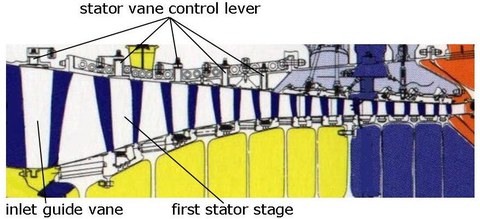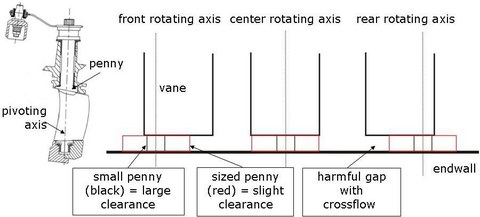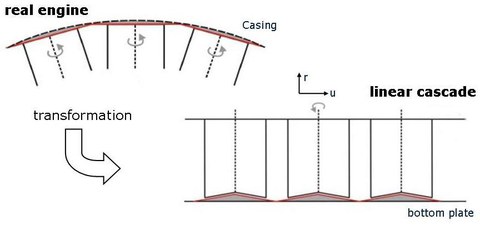Design of radial gap and endwall contouring of variable guide vanes in axial compressors
| Projektleiter: | Prof. Dr.-Ing. Konrad Vogeler |
| Bearbeiter: | Dipl.-Ing. Marcel Gottschall |
| Wissenschaftliche Kooperation: | keine |
| Finanzierung: | Deutsche Forschungsgemeinschaft DFG, Fördernummer VO 820/4-1 bzw. VO 820/4-2 |
| Bearbeitungszeitraum: | 02/08 - 01/11, Erweiterung 02/11 - 01/13 |
Description:
In modern aircraft engines the loading of each component has to be intensified to meet the increasing requirements regarding higher power density while reducing the engine masses.
Previous experiences and investigations have shown that additional measures have to be applied in particular to the compressor to gain even though a wide stable operating range under these conditions.
In case of compressor operation at non design revolutions the velocity vectors have to be adapted to the altering axial flow in order to avoid flow separations. It is one approach to equip the first stator stages of high pressure compressors with variable guide vanes to control the flow pattern. Due to the complex annulus geometry by rotational symmetry and axial cross section reduction radial gaps arise depending on the stagger angle with harmful tip clearance flows.
These clearance flows and their losses become more and more important because of the continuous aerodynamic improvements that are done at the mainflow. Hence, investigations in a linear cascade about the effects to the secondary flow field and global characteristics like cascade turning, total pressure losses and vorticity distribution shall improve the general knowledge of the complex flow interactions. Cascade tunnel experiments with variable gap geometry and several endwall contours (to minimize the radial gap in real engines) will be carried out in this poject with the aim of an evaluation of that clearance flow effects. The approach is shown in the figures.
At first, configurations of gap position and dimensions along the blade chord with optimized losses are chosen by measurements with conventional steady pneumatic techniques. Subsequently, the flowfield of these configurations will be investigated by optical methods and unsteady techniques more in detail to understand the development and interactions of the different secondary flows.
Associated with the experiments the cascade flow is simulated at several gap geometries. By means of an adapted and enhanced numerical model it is possible to analyse further geometry variations as well as to carry out tests on the alienability of the results to rotating machinery in a reasonable way with minimized expensive experiments.


